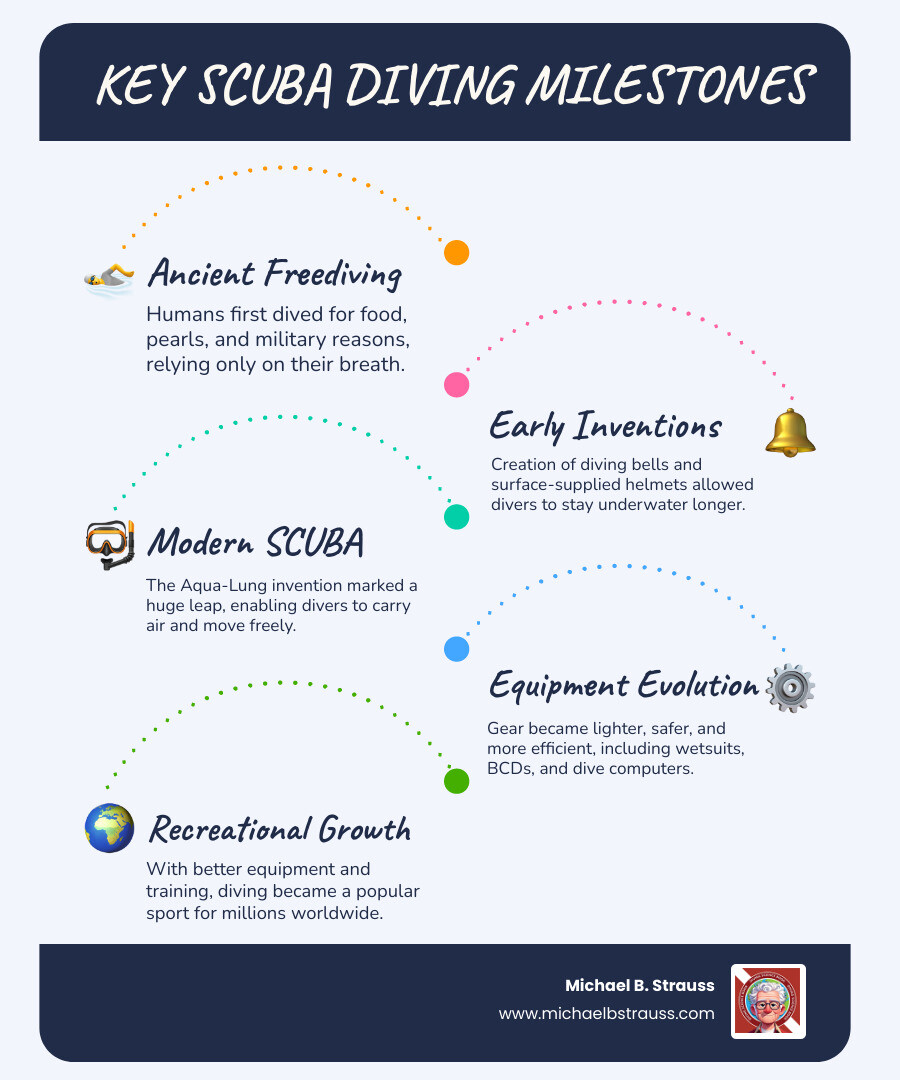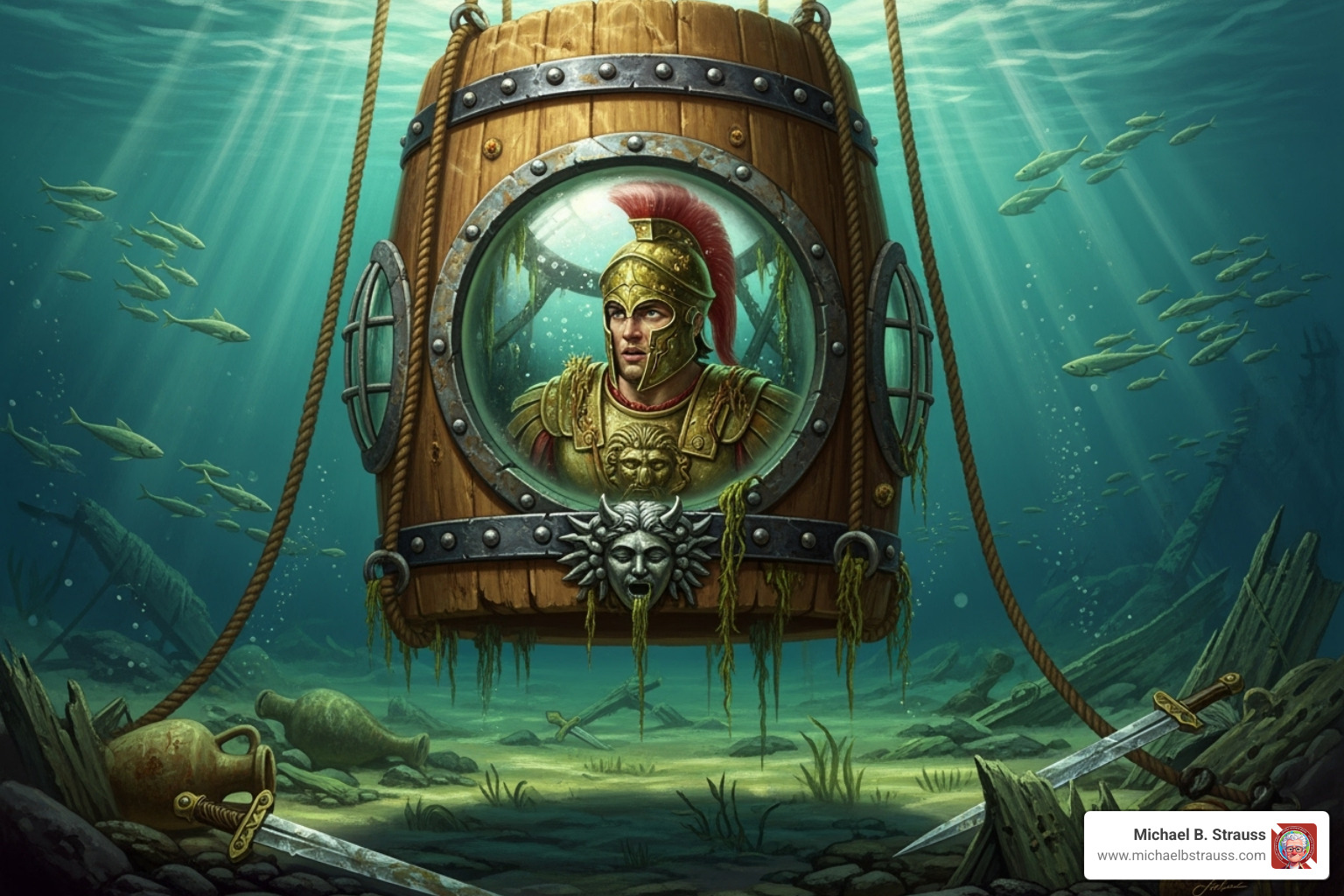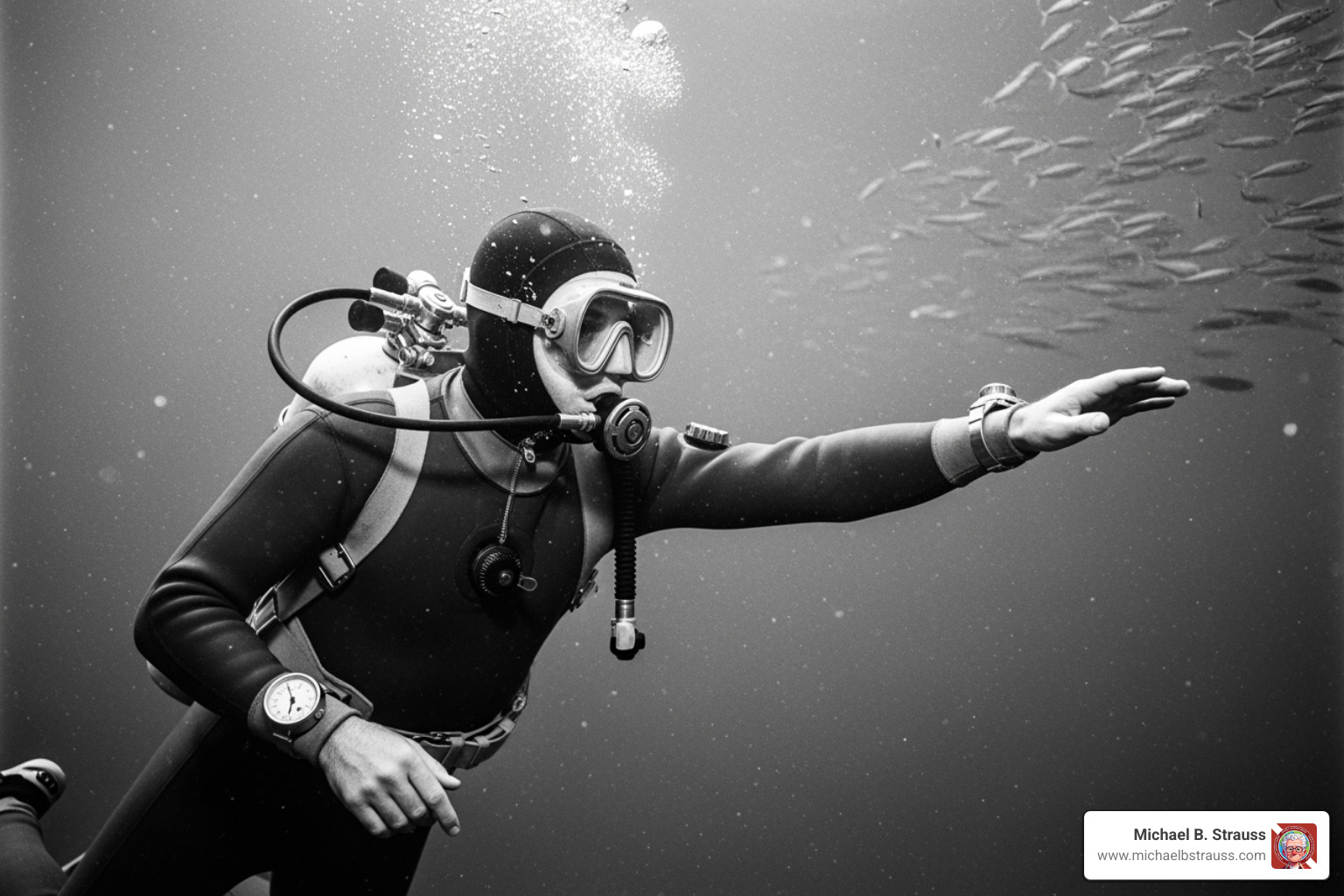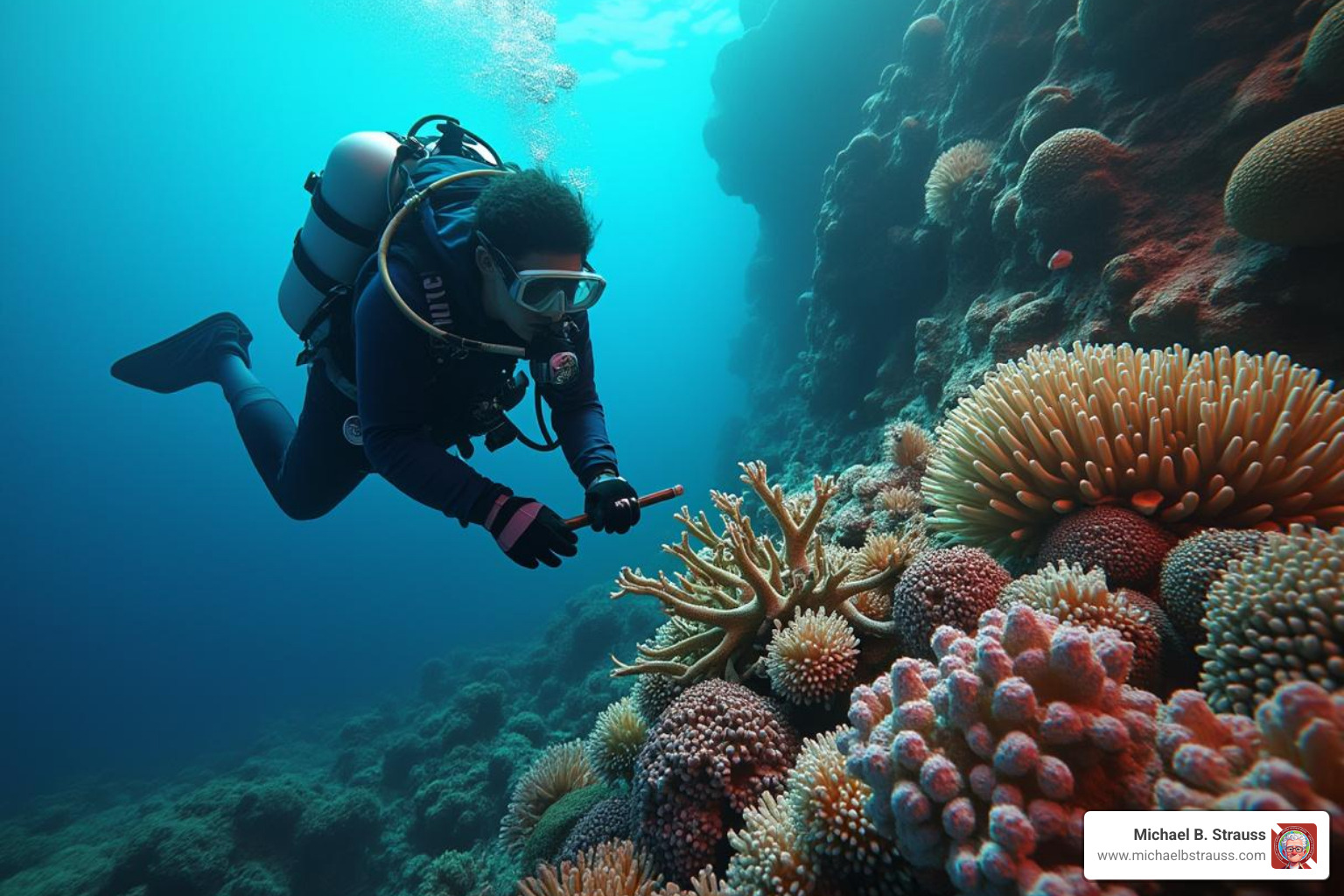The Unfolding Story of Underwater Exploration
The history of scuba diving is a tale as deep and vast as the ocean itself, tracing humanity's journey from simple breath-holding to complex underwater breathing systems. This evolution showcases a relentless desire to explore what lies beneath the waves.
The journey can be summarized in a few key stages:
- Ancient Freediving: The earliest explorations were done on a single breath for food, pearls, or military advantage.
- Early Inventions: Diving bells and surface-supplied helmets allowed divers to stay underwater for longer periods.
- Modern SCUBA: The invention of the Aqua-Lung enabled divers to carry their own air supply, granting true freedom of movement.
- Equipment Evolution: Gear became safer and more efficient with the advent of wetsuits, BCDs, and dive computers.
- Recreational Growth: Improved equipment and standardized training made diving a popular sport for millions.
From ancient sponge gatherers to modern deep-sea explorers, the story of scuba is one of continuous innovation, driven by human curiosity. As Gilbert Klingel noted of the deep's allure: "Finally I could resist the temptation no longer; I had to see what the edge of that submarine cliff was like." This drive has shaped every step of scuba's evolution.

The Complete History of Scuba Diving: From Ancient Times to Modern Tech
Ancient Origins and Early Underwater Exploration
Long before modern equipment, humans explored the underwater world on a single breath. Archaeological evidence shows that skin diving for shells and pearls dates back thousands of years. These early freedivers gathered food, sponges, and precious materials, relying solely on their lung capacity. Ancient texts hint at the desire to stay submerged longer. The Greek philosopher Aristotle described a primitive diving bell, a concept famously depicted in legends of Alexander the Great descending in a glass bell. Early divers also used rudimentary tools, such as polished tortoise shells for goggles, laying the groundwork for future innovations in the history of scuba diving.

The Age of Invention: Diving Bells, Helmets, and Early Apparatus
As ambition grew, inventors created mechanical aids to conquer the deep. The diving bell became more practical in the 17th century, with Edmond Halley designing a version that could replenish its air supply. The 18th century saw early attempts at individual diving suits, like John Lethbridge's "diving engine," a sealed barrel with armholes for salvaging treasure. The 19th century brought a major breakthrough with surface-supplied diving. Augustus Siebe's "closed diving dress" (1837), featuring a helmet connected to a surface air pump, became the standard for commercial and military diving for over a century. The dream of untethered diving persisted, leading to the first workable self-contained oxygen rebreather in 1876, a critical step toward the freedom of modern scuba.
The Birth of Modern SCUBA: Cousteau, Gagnan, and the Aqua-Lung
The mid-20th century marked the true dawn of modern scuba. The breakthrough came in 1943 from the collaboration of Jacques-Yves Cousteau, a French naval officer, and Émile Gagnan, an engineer. They adapted a demand regulator Gagnan had designed for gas-powered engines into an underwater breathing apparatus. This device, which they called the Aqua-Lung, was because it supplied air only when the diver inhaled, conserving the limited air supply. For the first time, divers could move freely, carrying their own air. While Cousteau and Gagnan created the device, the acronym SCUBA (Self-Contained Underwater Breathing Apparatus) was coined by Dr. Christian J. Lambertsen, an American who developed his own rebreather for military frogmen. The Aqua-Lung open uped the ocean for exploration, science, and recreation.

The Evolution of Scuba Gear: A Technological Timeline in the History of Scuba Diving
The Aqua-Lung was just the beginning. The following decades saw an explosion of innovation that made diving safer and more accessible.
| Early Diving Gear | Modern Gear |
|---|---|
| Siebe Helmet (1837) | Single-Hose Regulator (1952) |
| - Heavy, surface-supplied | - Lightweight, demand-based |
| - Limited mobility | - Allows free movement, easier breathing |
| Aqua-Lung (1943) | Buoyancy Control Device (BCD) (1965) |
| - Twin-hose, bulky | - Integrated vest for buoyancy control |
| - No integrated buoyancy | - Essential for neutral buoyancy and safety |
| Basic Mask/Fins (1930s) | Integrated Dive Computer (1983) |
| - Simple rubber/glass | - Digital, real-time depth, time, decompression |
| - Limited design | - Personalized dive planning |
| No thermal protection | Wetsuits/Drysuits (1930s/later) |
| - Divers relied on endurance | - Advanced thermal insulation |
| No depth/time monitoring | Specialized Gas Mixtures (1980s onwards) |
| - Manual calculation or guesswork | - Nitrox, Trimix for extended bottom time/depth |
Key advancements transformed the sport. The bulky twin-hose regulator of the original Aqua-Lung gave way to the simpler, more efficient single-hose regulator, which remains the standard today. Wetsuits, popularized in the 1950s, provided essential thermal protection. The invention of the Buoyancy Control Device (BCD) in the 1960s was a major safety improvement, allowing divers to effortlessly control their depth. Perhaps the most significant safety innovation was the digital dive computer in 1983, which replaced manual calculations with real-time decompression data. Finally, the introduction of specialized gas mixtures like Nitrox and Trimix allowed recreational and technical divers to safely extend their bottom times and explore greater depths.
From Niche to Mainstream: The Rise of Recreational Diving
Initially, diving was for military and commercial specialists. The transition to a popular recreational sport was driven by media and standardized training. Jacques Cousteau's books and documentaries, like The Silent World, captivated global audiences. In the United States, the TV show "Sea Hunt" (1958-1961) glamorized diving and inspired thousands to try it. This growing interest created a need for formal training. The establishment of certification agencies like the National Association of Underwater Instructors (NAUI) in 1960 and the Professional Association of Diving Instructors (PADI) in 1966 was crucial. These organizations created structured courses and safety protocols, making diving accessible and safe for millions and changing it into the global sport it is today.

The Future of Underwater Exploration
Modern Applications and the Future of Scuba Diving
Beyond recreation, scuba technology is vital across numerous fields. Commercial divers build and maintain underwater infrastructure like oil rigs, while military divers conduct stealthy reconnaissance and ordnance disposal. In the field of science, scuba is an indispensable tool for marine biologists, archaeologists, and oceanographers to conduct fieldwork. Public safety divers perform critical search and rescue operations, and underwater photographers bring the beauty of the deep to the surface.

The history of scuba diving is still being written, with future advancements promising to make diving safer and more accessible. We can expect smarter, more streamlined gear, with dive computers potentially integrating heads-up displays inside the mask. Advanced breathing systems like closed-circuit rebreathers (CCRs), which recycle gas and allow for longer, bubble-free dives, will likely become more user-friendly and affordable for recreational use. Improved underwater communication systems and continued evolution in online training will further improve safety and efficiency.
As we continue to explore, the focus on environmental responsibility and marine conservation will grow, with technology helping us monitor and protect fragile underwater ecosystems. The future of diving is as exciting as its past. Understanding the science behind it is key to enjoying these experiences safely and responsibly.
To learn more about the science and safety that shaped modern diving, get your copy of "Diving Science Revisited" today! https://www.bestpub.com/view-all-products/product/diving-science-revisited/category_pathway-48.html
Michael B. Strauss proudly serves the global diving community with educational resources and expertise in diving science and safety.
DISCLAIMER: Articles are for "EDUCATIONAL PURPOSES ONLY", not to be considered advice or recommendations.






